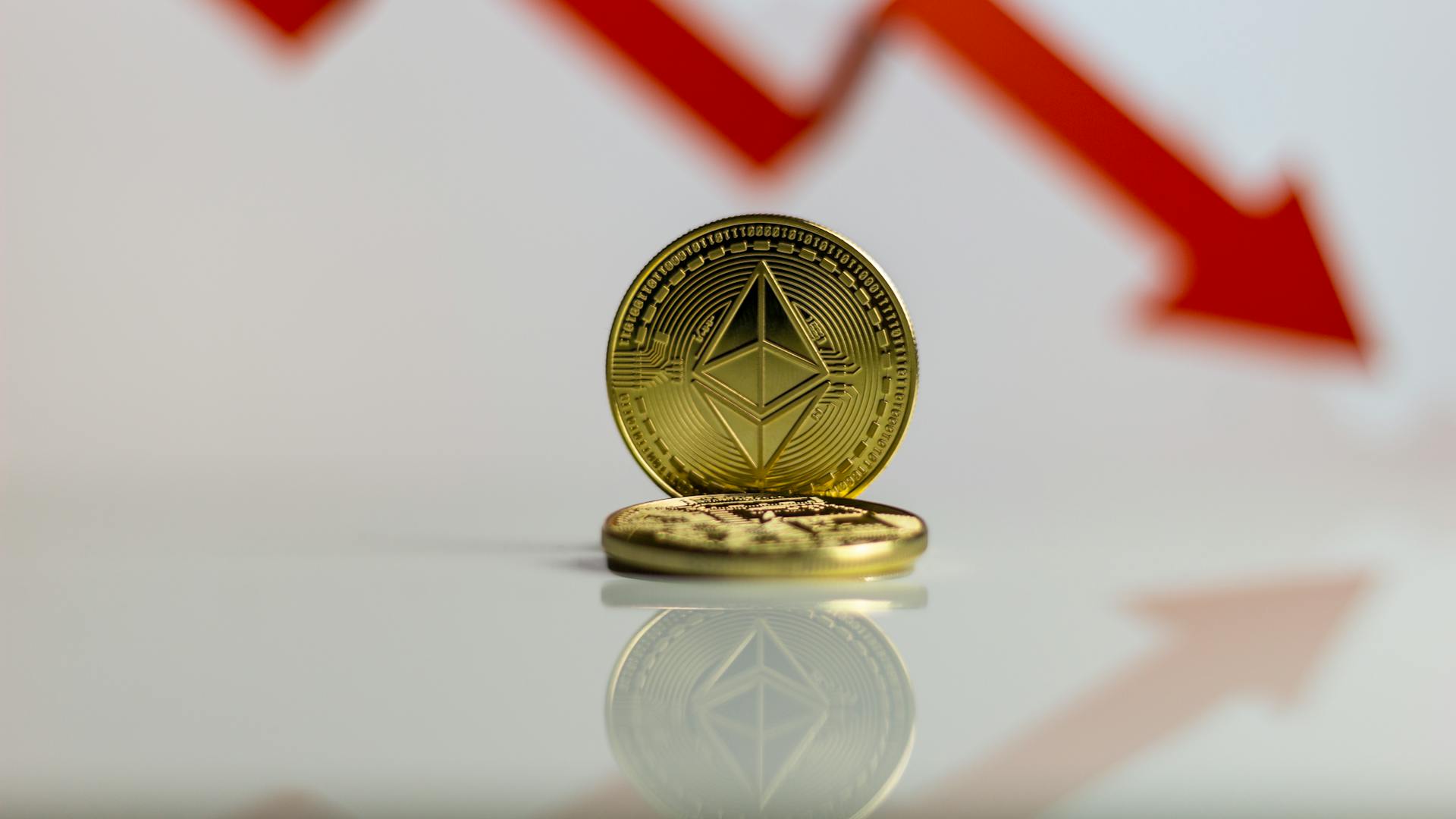
The crypto winter has been a long and brutal one, with prices plummeting and investor confidence shaken.
The current state of the market is a far cry from the wild price swings and hype that characterized the 2017 bull run.
One major factor that's contributed to the prolonged downturn is the decline in global economic growth, particularly in China, which has historically been a major driver of cryptocurrency adoption.
The impact of this economic slowdown has been felt across the board, with even the most resilient cryptocurrencies struggling to stay afloat.
Some analysts are predicting that the market will start to recover once global economic growth picks up again, but until then, it's likely to remain a challenging time for investors.
Causes of Crypto Winter
Poor economic conditions can trigger a crypto winter. This is because traders tend to feel more comfortable exiting riskier crypto assets when macroeconomic factors like unemployment, interest rates, or inflation aren't favorable.
The winter season can also add price volatility to the virtual currency sector, especially when there's FUD around other asset categories like stocks.
Scandals or hacks can also lead to a crypto winter. For example, the hack of 850,000 BTC on the Mt.Gox exchange in 2014 sent Bitcoin's price into a multiyear slump, and more recently, the bankruptcies of crypto exchanges like FTX and the collapse of crypto projects like Terra Luna put a strain on crypto prices in 2022.
Related reading: Is Crypto Winter over
Poor Economic Data
Poor economic data can really hurt the crypto market.
If the overall global economy is unstable, traders tend to feel more cautious and less likely to take risks with their portfolios.
Cryptocurrencies, due to their volatile nature, tend to perform best in a stable economic environment.
This means that if macroeconomic factors like high unemployment, rising interest rates, or inflation aren't favorable, traders might feel more comfortable selling their crypto assets, triggering a bear market.
Additionally, if there's FUD around other asset categories like stocks, it can add to the price volatility in the crypto sector, making things even tougher for traders.
Scandals or Hacks
Scandals or hacks can have a devastating impact on the crypto market. The hack of 850,000 BTC on the Mt.Gox exchange in 2014 is a prime example.
Major security breaches can send Bitcoin's price into a multiyear slump, as seen in 2014. This highlights the importance of robust security measures in the crypto space.
The bankruptcies of crypto exchanges like FTX and the collapse of crypto projects like Terra Luna put a significant strain on crypto prices in 2022. These events can erode trust in the market and lead to a downturn in prices.
The aftermath of these events can be particularly challenging for investors, who may see a significant loss in value. This is why it's essential to stay informed and vigilant in the face of market volatility.
Minimal Mainstream Interest
During crypto winters, search activity for terms like "Bitcoin" and "crypto" tends to wane on websites like Google.
People tend to lose interest in following crypto news when volumes are low and prices aren't pumping.
Major news stories on cryptocurrencies during crypto winters are often negative, influenced by fear, uncertainty, and doubt (FUD).
This lack of interest is reflected in the decreased search activity, making it harder for people to stay informed about the latest developments in blockchain technology and Web3.
A different take: Cryptocoin News
Do Affect All Currencies?
In a typical crypto winter, the majority of cryptocurrencies are affected. This is because a market-wide downturn is a common occurrence during crypto winter periods. Most cryptocurrencies experience a decline in value, making it a challenging time for investors.
The possibility of exceptions does exist, but investors should still plan on a downturn during crypto winter periods. This is the general expectation, and it's essential to be prepared.
If this caught your attention, see: Crypto Winter
Effects of Crypto Winter
Crypto winter has been a challenging time for many investors, with the market experiencing a significant decline in value. This has led to a decrease in trading volume and a shift in investor sentiment.
Many investors have lost money during this period, with some reporting losses of up to 90% of their initial investment. This has resulted in a loss of trust in the crypto market.
The decline in value has also led to a decrease in the number of new investors entering the market. This has resulted in a decrease in the overall market capitalization of cryptocurrencies.
The prolonged period of low prices has also led to a decrease in the number of active traders and exchanges. This has resulted in a decrease in the overall liquidity of the market.
Despite the challenges, some investors are holding on to their assets, hoping for a recovery. This has resulted in a decrease in the number of coins being sold on the market.
The decrease in trading volume has also led to a decrease in the number of new projects being launched. This has resulted in a decrease in the overall innovation in the space.
Surviving Crypto Winter
Surviving crypto winter requires preparation and a clear strategy.
While crypto winters can be daunting, they also present unique opportunities for those who are prepared.
It's understandable to feel down during crypto winters, but there are ways to preserve purchasing power and capitalize on discounted prices.
Holding onto large positions in multiple coins, also known as HODLing, can be a viable strategy during this phase.
Beyond Bear Markets
A crypto winter is not just a bear market with a different name. A bear market is a period when stocks are lower in value, often due to economic factors, but cryptocurrencies have their own unique dynamics.
Stock prices are determined by market forces, but cryptocurrencies lack robust valuation models, leading to a disconnect between stocks and cryptos. This can make it challenging to predict crypto prices.
You don't have to feel down during a crypto winter, though. There are ways to preserve your purchasing power and even capitalize on discounted prices for crypto assets.
Diversifying your portfolio across multiple cryptocurrencies and blockchain projects can help spread risk. This is especially true when investing in different sectors, such as DeFi, NFTs, and blockchain infrastructure.
Crypto winters can be a great opportunity to explore alternative income streams within the crypto ecosystem. Staking, lending, and yield farming are some popular ways to generate passive income with your cryptocurrency holdings.
Recommended read: When Will Wwe Be in Philadelphia?
Are Worthless?
Some people think cryptocurrencies are worthless and will eventually fall to zero. This is a valid concern, but it's not a guarantee. In fact, a study by Aspembitova et al. found that the behavioral structure of users in the cryptocurrency market is complex and influenced by various factors.
The cryptocurrency market is highly volatile, and prices can fluctuate rapidly. This is evident in the Bitcoin price chart on CoinMarketCap, which shows a significant drop in 2022.
Investors and buyers need to carefully evaluate the risks and potential returns before investing in cryptocurrencies. The Consumer Financial Protection Bureau warns that virtual currencies pose risks to consumers, including the potential loss of funds.
A study by Kumar et al. suggests that on-chain asset tokenization can be a relevant solution during a "crypto winter." This involves creating digital tokens that represent ownership of assets, such as real estate or art.
The International Monetary Fund notes that the crypto ecosystem and financial stability challenges are interconnected. This highlights the need for a comprehensive approach to addressing the risks and opportunities associated with cryptocurrencies.
Here's a summary of the key risks associated with cryptocurrencies:
- Rapid price fluctuations
- Potential loss of funds
- Regulatory risks
- Liquidity risks
It's essential to carefully consider these risks and potential returns before investing in cryptocurrencies. By doing so, you can make informed decisions and navigate the challenges of crypto winter.
Getting Started

If you're new to the world of cryptocurrency, the current market downturn might seem overwhelming. The crypto winter has been ongoing since 2022, with prices plummeting and many investors losing money.
The first step to getting started is to understand the basics of cryptocurrency. According to our previous section, the total market capitalization of cryptocurrencies has dropped from $3 trillion to $1.5 trillion since its peak in 2021.
To navigate this challenging market, it's essential to have a solid understanding of risk management. A study mentioned in our section on "Understanding the Risks" showed that 70% of investors who lost money in the 2022 market crash were those who didn't have a clear investment strategy.
What Are ETFs?
ETFs, or Exchange-Traded Funds, are a type of investment that allows you to buy a small piece of a larger portfolio of assets, making it easier to diversify your investments.
They work similar to how buying virtual coins works, but instead of buying individual coins, you're buying a small piece of a fund that holds a variety of assets.
Curious to learn more? Check out: Earn Crypto Coins

ETFs are traded on stock exchanges, like stocks, and their prices can fluctuate throughout the day.
You can buy and sell ETFs through a brokerage account, just like you would with individual stocks.
This makes it a convenient option for investors who want to gain exposure to a particular market or asset class without having to buy and hold individual securities.
On a similar theme: Buy Starlink Crypto
5 Ways to Get Started
Getting started with crypto trading can be overwhelming, but having a clear direction can make all the difference. Crypto trading strategies give traders a sense of direction in the digital assets market.
To get started, you need to discover the pro techniques to calculate your risks and returns. This will help you make informed decisions and avoid costly mistakes.
One way to get started is by learning about different types of trading strategies, such as scalping, day trading, and swing trading. Each strategy has its own unique characteristics and risks.

Understanding your risk tolerance is crucial when it comes to crypto trading. You need to be aware of your risk level and adjust your strategy accordingly.
A good starting point is to set clear goals for yourself, such as short-term or long-term gains. This will help you stay focused and motivated throughout your trading journey.
By following these steps, you'll be well on your way to getting started with crypto trading and making informed decisions in the digital assets market.
Frequently Asked Questions
Will crypto rise again in 2025?
Yes, industry experts predict a significant rise in crypto, with some forecasting bitcoin to hit $200,000 in 2025. This potential surge has investors and executives optimistic about the future of cryptocurrency.
Sources
- https://www.investopedia.com/crypto-winter-5496605
- https://rethinking65.com/is-the-crypto-winter-over/
- https://dydx.exchange/crypto-learning/crypto-winter
- https://investmentu.com/crypto-winter/
- https://www.vritimes.com/sg/articles/eff2b400-6b2f-11ef-86e5-0a58a9feac02/7a2746f1-a513-11ef-a001-0a58a9feac02
Featured Images: pexels.com


